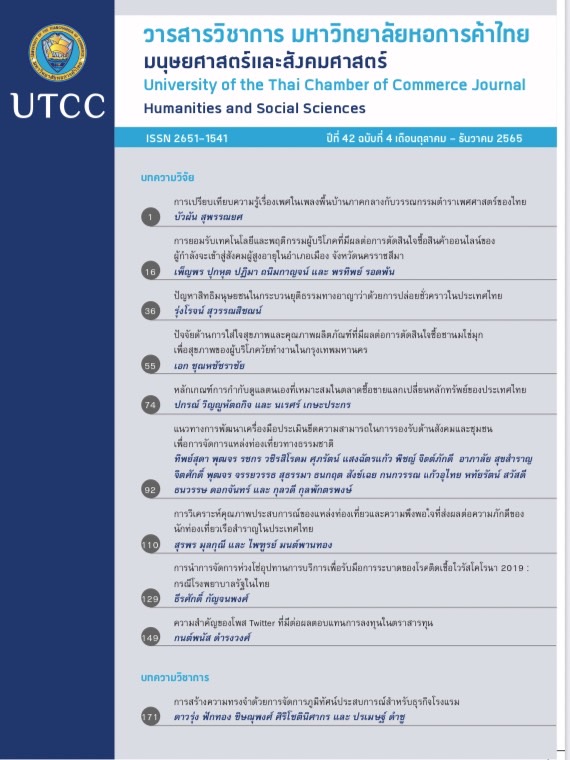Guidelines of the Development of Society and Community Carrying Capacity Evaluation Tool for Natural Tourism Destination Management
Main Article Content
Abstract
This research aims to study on guidelines of the development of social and community carrying capacity evaluation tool for natural tourism destination management by mixed method research. The evaluation tool was created and to be used by experts, government officials, entrepreneurs, local people, and tourists in the natural tourism destination management. Moreover, the tool was tested on statistical indicators, and piloted in the case study site by analyzing means (x), standard deviation (S.D.), and score values for data analysis. The results demonstrated that the social carrying capacity evaluation is a review of impacts, risks, safety, and level of acceptance of factors and characteristics of indicators that could be separated into two parts including 1)government officials who are responsible for tourism destination management (national park and sanctuary) which are the feeling of congestion by perception, and visitor density; 2) for community that involves in tourism management which are population change, socio-cultural values or wisdom, social conflict, life quality, wellness, safety and satisfaction of local people.
Article Details

This work is licensed under a Creative Commons Attribution-NonCommercial-NoDerivatives 4.0 International License.
ลิขสิทธิ์ของบทความ
ผลงานที่ได้รับการตีพิมพ์ถือเป็นลิขสิทธิ์ของมหาวิทยาลัยหอการค้าไทย ห้ามมิให้นำเนื้อหา ทัศนะ หรือข้อคิดเห็นใด ๆ ของผลงานไปทำซ้ำ ดัดแปลง หรือเผยแพร่ ไม่ว่าทั้งหมดหรือบางส่วนโดยไม่ได้รับอนุญาตเป็นลายลักษณ์อักษรจากมหาวิทยาลัยหอการค้าไทยก่อน
References
จิตศักดิ์ พุฒจร, ทิพย์สุดา พุฒจร, รชกร วชิรสิโรดม, ศุภรัตน์ แสงฉัตรแก้ว, พิชญ์ จิตต์ภักดี, อาภาลัย สุขสำราญ, …กุลวดี กุลพักตรพงษ์. (2565). การศึกษาและจัดทำคู่มือประเมินขีดความสามารถในการรองรับของแหล่งท่องเที่ยวประเภทภูเขา ถ้ำ และพื้นที่เกี่ยวข้อง. เพชรบุรี: มหาวิทยาลัยศิลปากร,คณะวิทยาการจัดการ.
จิตศักดิ์ พุฒจร, ศุภรัตน์ แสงฉัตรแก้ว, ทิพย์สุดา พุฒจร, พิชญ์ จิตต์ภักดี, อาภาลัย สุขสำราญ, พฤทธิ์ พุฒจร, … วรัญญา ยิ้มแย้ม. (2564). คู่มือการประเมินขีดความสามารถในการรองรับได้ของแหล่งท่องเที่ยวในพื้นที่ชุมชนย่านเมืองเก่า. กรุงเทพฯ: จุฬาลงกรณ์มหาวิทยาลัย.
ธนะวิทย์ เพียรดี, และวนิดา อ่อนละมัย. (2564). แนวทางการพัฒนาการท่องเที่ยวโดยชุมชนไปสู่แหล่งท่องเที่ยวสีเขียวอย่างมีความรับผิดชอบ: กรณีศึกษาบ้านเกาะเคี่ยม ตำบลกันตังใต้ อำเภอกันตัง จังหวัดตรัง.วารสารรัฐศาสตร์มหาวิทยาลัยราชภัฏสวนสุนันทา, 4(1), 24-27.
นราวดี บัวขวัญ, วนิดา เพ็ชร์ลมุล, และภัชภุล ตรีพันธ์. (2559). ขีดความสามารถในการรองรับของการท่องเที่ยวโดยชุมชนในพื้นที่ 5 จังหวัดชายแดนภาคใต้ (สตูล สงขลา ปัตตานี ยะลา และนราธิวาส). กรุงเทพฯ:สำนักงานคณะกรรมการวิจัยแห่งชาติ และสำนักงานกองทุนสนับสนุนการวิจัย
วัฒนา สุนทรธัย. (2551). เหตุผลที่อยู่เบื้องหลังการพัฒนาเกณฑ์การตัดสินใจชนิด 5 ระดับ. Executive Journal, 28(3), 97-101. สืบค้นจาก https://www.bu.ac.th/knowledgecenter/executive journal/july_sep_08/july_sep_08.html
สำนักงานการพัฒนาเศรษฐกิจและสังคมแห่งชาติ. (2564). เอกสารประกอบการระดมความคิดเห็นกรอบแผนพัฒนาเศรษฐกิจและสังคมแห่งชาติ ฉบับที่ 13. กรุงเทพฯ: ผู้แต่ง.
สุภาวิณี ทรงพรวาณิชย์. (2557). คู่มือการประเมินขีดความสามารถในการรองรับการท่องเที่ยวโดยชุมชน.กรุงเทพฯ: สำนักงานคณะกรรมการส่งเสริมวิทยาศาสตร์วิจัยและนวัตกรรม.
แสงสรรค์ ภูมิสถาน, จิรนันท์ นิสัยหาญ, และเนรมิต สงแสง. (2562). ขีดความสามารถในการรองรับด้านกายภาพและระดับการใช้ประโยชน์ด้านนันทนาการ ในพื้นที่อุทยานแห่งชาติธารโบกขรณี จังหวัดกระบี่. วารสารการจัดการสิ่งแวดล้อม, 15(2), 4-25. สืบค้นจาก https://www.tci-thaijo.org/index.php/JEM/article/download/218010/157191
องค์การบริหารการพัฒนาพื้นที่พิเศษเพื่อการท่องเที่ยวอย่างยั่งยืน. (2561). เกณฑ์การท่องเที่ยวอย่างยั่งยืนโลก (Global sustainable tourism criteria: GSTC). กรุงเทพฯ: ผู้แต่ง.
Iiyama, Y., & Susanti, R. (2004). Community perspectives on ecotourism carrying capacity: case studies from three bordering villages of Kayan Mentarang National Park, Indonesia. Sustainable Tourism, 76, 37-46. Retrieved from https://www.witpress.com/Secure/elibrary/papers/ST04/ST04004FU.pdf
Joshi, S., & Dahal, R. (2019). Relationship between social carrying capacity and tourism carrying capacity: A case of Annapurna Conservation Area, Nepal. Journal of Tourism & Hospitality Education, 9, 9-29. Retrieved from https://www.nepjol.info/index.php/JTHE/article/view/23677/20073
Lane, M. (2014). The development of a carrying capacity assessment model for the Australian socio-environmental context (Unpublished doctoral dissertation). Queensland University of Technology
Marzetti Dall’Aste Brandolini, S., & Mosetti, R. (2005). Social carrying capacity of mass tourist sites: Theoretical and practical issues about its measurement. Natural Resource Management, 1-22. Retrieved from https://www.feem.it/m/publications_pages/NDL2005-144.pdf
Yusoh, M. P., Mapjabil, J., Hanafi, N., & Idris, M. A. (2021). Tourism carrying capacity and social carrying capacity: a Literature review. ICMESH 2020 (pp. 1-11). Perak, Malaysia: SHS Web of Conferences.
Zekan, B., Weismayer, C., Gunter, U., Schuh, B., & Sedlacek, S. (2022). Regional sustainability and tourism carrying capacities. Journal of Cleaner Production, 339, [130624]. doi: 10.1016/j.jclepro.2022.130624
Zelenka, J, & Kacetl, J. (2014). The Concept of carrying capacity in tourism. Amfiteatru Economic Journal, 16(36), 640-654. Retrieved from https://www.econstor.eu/bitstream/10419/168848/1/aej-v16-i36-p0641.pdf.


